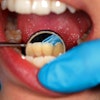Maryland researchers have developed a novel antibacterial orthodontic bracket cement, which was presented at the recent American Association for Dental Research (AADR) meeting.
Mary Anne Sampaio de Melo, DDS, PhD, from the University of Maryland, Baltimore, presented the research, "Antibacterial Orthodontic Cement Containing a Quaternary Ammonium Monomer Dimethylaminododecyl Methacrylate" at last week's meeting in Charlotte, NC, according to the AADR.
Demineralized lesions in enamel around orthodontic brackets are caused by acids from biofilm accumulation. The objectives of the study were to develop a novel antibacterial orthodontic bracket cement by incorporating a quaternary ammonium monomer dimethylaminododecyl methacrylate (DMADDM), and investigate the effects on dental plaque microcosm biofilm response and enamel bond strength.
The researchers synthesized DMADDM with an alkyl chain length of 12 and incorporated it into the cement at mass fractions of 0%, 1.5%, and 3%. Orthodontic cement Transbond XT (3M Unitek) served as control. The researchers also measured the shear bond strength of metal brackets to human enamel.
Cement remnant index scores were determined after bracket failure. The researchers used a plaque microcosm biofilm model with human saliva as inoculum to measure metabolic activity, lactic acid production, and colony-forming units for biofilms on orthodontic cements.
The researchers found that incorporating DMADDM into orthodontic cement did not affect the shear bond strength (13.1 to 14.6 MPa; p = 0.09). Dental plaque microcosm biofilm viability was substantially inhibited when in contact with cement disks containing DMADDM. The new orthodontic adhesive reduced biofilm metabolic activity by up to 66% and lactic acid by 78% (p < 0.05), they found. Biofilm total microorganisms were reduced by up to 88%, total streptococci by 96%, and mutans streptococci by 98% (p < 0.05).
Increasing DMADDM mass fraction increased the antibacterial potency, according to the researchers. Orthodontic cement containing 3% DMADDM was the most strongly antibacterial. These results show that the DMADDM-containing orthodontic cement inhibited biofilms and lactic acid without compromising the enamel bond strength, and hence may be promising to reduce or eliminate demineralization in enamel around orthodontic brackets, they concluded.















